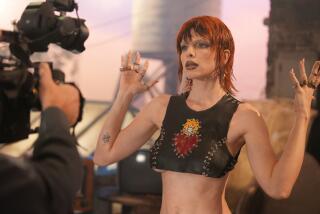Mushroom-made fashion authority Aniela Hoitink talks global change-sparked innovation
- Share via
Mention of mushrooms conjure all sorts of images, but for Dutch textile designer Aniela Hoitink mushroom mycelium can be a course for fashion.
Among this year’s winners of The Global Change awards, Hoitink is taking part in an incubator program in New York this week. The crash course is made possible through Accenture, KTH Innovation of Sweden and the H&M Foundation. Other winners include Agraloop, which makes sustainable textiles from leftover crop harvests; Swerea, which separates cotton and polyester blends for a new textile fiber; Algalife, which transforms algae into eco-friendly dye; Resortecs, which creates a dissolvable thread and the Early Bird winner Tandem Repeat, which uses self-healing textiles to reduce garment waste.
Four years ago Hoinik started working with mycelium — mushroom roots, but it took two years to figure out a way to create a flexible material. The trick was to figure out how to avoid the brittleness that is a result of drying it. The second step was how to make materials from it without having a standard supply chain. Combined with 3-D technology, they’ve found a way to produce custom-made clothes out of this new natural fiber without the need to cut and sew. Once her designs are worn out, the garments are meant to be buried in the ground to decompose. “I thought it was an opportunity to look at a way we look at the production of textiles, and garments,” she said, adding that the first dress she developed two years ago generated a lot of interest.
A participant in last year’s Fashion for Good accelerator program, the Dutch-born Global Change award winner said, “It’s really nice that the industry is validating the idea of having a new supply chain that would be something for the future.” After studying fashion design at the Utrecht School of Arts, she worked for various fashion companies including Tommy Hilfiger as a print and men’s wear designer in The Netherlands.
Ten years ago not wanting to design another shirt or jacket, she focused on technology, at first solar energy and lightening power, before moving into microbiology from the advantages of working with fungi — antimicrobial and skin-care properties. Rather than zero in on the image-enhancing effects of fashion, she wants people to consider more sustainable factors by examining the biological lifecycle. “Fashion has a consumptive behavior right now,” she said, adding that she aims to have developed a system to improve the fashion system in 10 years. Three-dimensional molding would be one asset, adding the investment would take upward of $2 million.
This week the Global Change winners will be part of “the dragons’ den,” an opportunity to fine-tune their pitches for investors, she said. They also visited the Council of Fashion Designers of America Monday morning, and meet with different brands later this week. “The nice thing about this program is they are helping us develop our companies at every level — how to think about IT, ways to improve your team.…After this week, I will have a clear strategic plan for MycoTex.”
Convinced that the future of fashion is collaboration, Hoitink is working with several universities for research and material, and fashion designers. “No one company can do it alone. We need each other,” she said. “In order to change the world, we need to have regulations, to change the consumers’ [consumptive behavior] and the industry. The most important thing is to start with yourself. By doing small things like turning off the light or buying garments that last longer, we can improve the system. Maybe that’s also logical but a lot of people don’t realize how much pollution the fashion industry and our behavior can create.”
In New York for a week, the designer went to the Metropolitan Museum of Art’s “Heavenly Bodies: Fashion and the Catholic Imagination” last weekend. Interested in how stores treat shoppers and approach sustainability, she checked out Patagonia. Nike was another stop to check out their innovative materials and on-the-spot footwear customization. The latter is in sync with a key feature of MycoTex, which offer body-based molding for consumers’ varying body types. “My goal is to have mass-produced products with a customized option,” said Hoitink, adding that she is developing her own customized sustainable bags.







